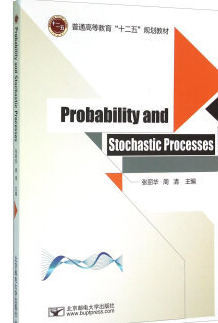 [内容推荐]
[内容推荐]《概率论与随机过程(英文版)》系统地介绍概率论与随机过程的基本概念、基本方法、基本理论以及应用。《概率论与随机过程(英文版)》分为8章。前4章介绍概率论的一般知识及应用,后四章介绍随机过程的一般知识及应用。
《概率论与随机过程(英文版)》注重概念之间的联系和背景介绍,强调知识的应用,而且《概率论与随机过程(英文版)》所有内容是自包含的,讲述浅显易懂,便于自学。
《概率论与随机过程(英文版)》供非数学专业、应用型本科理工类一学期(64—72学时)学习使用。
[目录]
Chapter 1 Events and Their Probabilities
1.1 The History of Probability
1.2 Experiment, Sample Space and Random Event
1.2.1 Basic Definitions
1.2.2 Events as Sets
1.3 Probabilities Defined on Events
1.3.1 Classical Probability
1.3.2 Geometric Probability
1.3.3 The Frequency Interpretation of Probability
1.4 Probability Space
1.4.1 Axiomatic Definition of Probability
1.4.2 Properties of Probability
1.5 Conditional Probabilities
1.5.1 The Definition of Conditional Probability
1.5.2 The Multiplication Rule
1.5.3 Total Probability Formula
1.5.4 Bayes' Theorem
1.6 Independence of Events
1.6.1 Independence of Two Events
1.6.2 Independence of Several Events
1.6.3 Bernoulli Trials
1.7 Review
1.8 Exercises
Chapter 2 Random Variable
2.1 The Definition of a Random Variable
2.2 The Distribution Function of a Random Variable
2.2.1 The Definition and Properties of Distribution Function . . .
2.2.2 The Distribution Function of Function of a Random Variable
2.3 Mathematical Expectation and Variance
2.3.1 Expectation of a Random Variable
2.3.2 Expectation of Functions of a Random Variable
2.3.3 Variance of a Random Variable
2.3.4 The Application cf Expectation and Variation
2.4 Discrete Random Variables
2.4.1 Binomial Distribution with Parameters n and p
2.4.2 Geometric Distribution
2.4.3 Poisscn Distribution with Parameters
2.5 Continuous Rsndom Variables
2.5.1 Uniform Distribution
2.5.2 Exponential Distribution
2.5.3 Normal Distribution
2.6 Review
2.7 Exerciscs
Chapter 3 Random Vectors
3.1 Random Vectors and Joint Distributions
3.1.1 Random Vectors and Joint Distributions
3.1.2 Discrete Random Vectors
3.1.3 Continuous Random Vectors
3.2 Independence cf Random Variables
3.3 Conditional Distributions
3.3.1 Discrete Case
3.3.2 Continuous Case
3.4 One Function of Two Random Variables
3.4.1 Discrete Case
3.4.2 Continuous case
3.5 Transformation of Two Random Variables
3.6 Numerical Charscteristics of Random Vectors
3.6.1 Expectation cf Sums and PIoducts
3.6.2 Covariance and Correlation
3.7 Multivariate Distributions
3.7.1 Distribution Functions of Multiple Random Vectors
3.7.2 Numerical Characteristics of Random Vectors
3.7.3 Multiple Normal Distribution
3.8 Review
3.9 Exercises
Chapter 4 Sequences of Random Variables
4.1 Family of Distribution Functions and Numerical Characteristics
4.2 Modes of Convergence
4.3 The Law of Large Numbers
4.4 The Central Limit Theorem
4.5 Review
4.6 Exercises
Chapter 5 Introduction to Stochastic Processes
5.1 Definition and Classification
5.2 The Distribution Family and the Moment Functions
5.3 The Moments of the Stochastic Processes
5.3.1 Mean, Autocorrelation and Autocovariance
5.3.2 Cross-correlation and Cross-covariance
5.4 Stochastic Analysis
5.5 Review
5.6 Exercises
Chapter 6 Stationary Processes
6.1 Stationary Processes
6.1.1 Strict Stationary Processes
6.1.2 Wide Stationary Processes
6.1.3 Joint Stationary Processes
6.2 Ergodicity of Stationary Processes
6.3 Power Spectral Density of Stationary Processes
6.3.1 Average Power and Power Spectral Density
6.3.2 Power Spectral Density and Autocorrelation Function
6.3.3 Cross-Power Spectral Density
6.4 Stationary Processes and Linear Systems
6.5 Review
6.6 Exercises
Chapter 7 Finite Markov Chains
7.1 Basic Concepts
7.2 Markov Chains Having Two States
7.3 Higher Order Transition Probabilities and Distributions
7.4 Invariant Distributions and Ergodic Markov Chain
7.5 How Does Google Work?
7.6 Review
7.7 Exercises
Chapter 8 Independent-Increment Processes
8.1 Independent-Increment Processes
8.2 Poisson Process
8.3 Gaussian Processes
8.4 Brownian Motion and Wiener Processes
8.5 Review
8.6 Exercises
Bibliography
Appendix
Table of Binomial Cofficients
Table of Binomial Probabilities
Table of Poisson Probabilities
Table of Normal Probabilities

 新书报道
新书报道